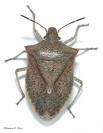Stink Bugs
Halyomorpha halys
 |
|
Several kinds of stink bugs feed on tomatoes, but all are similar in life history and damage. The most common species statewide is the consperse stink bug, which tends to be the most important species in the Sacramento and northern San Joaquin valleys. The redshouldered stink bug is considered the most prevalent species in the southern San Joaquin Valley. Chlorochroa sayi and C. uhleri are most prevalent on the west side of the San Joaquin Valley. The southern green stink bug, Nezara viridula, occurs in parts of the Sacramento and northern San Joaquin valleys, but is kept at relatively low levels by an imported parasite. Adult stink bugs are distinctly shield shaped and either brown or green. Some species have red, pink, or yellow markings. Adults overwinter on the ground under leaves, in orchards, legume crops, blackberries, or on certain weeds such as Russian thistle, mustards, and little mallow (cheeseweed). They become active in March and April and begin laying eggs at this time. Eggs are drum shaped with circular lids and are laid in clusters on foliage. Immatures resemble adults but do not have developed wings.
Habits
Most species of stink bugs are innocuous, only feeding on their host plants, and are seldom encountered by humans. Stink bugs feed on a variety of plants, including crop species. When stink bugs feed on tree fruits such as apples, it results in a characteristic distortion, referred to as \"cat facing,\" that renders the fruit unmarketable. Some species can cause damage in cotton and other crops. Predatory stink bugs use their mouthparts to drain fluids from other pest insects. Some predatory stink bugs are important, beneficial insects in crops and gardens. They prevent caterpillars and other insect pests from destroying plants, trees, crops and gardens. Scientists are interested in using them as natural control agents of crop pests. When handled or disturbed, stink bugs are able to secrete a bad-smelling, bad-tasting fluid from pores on the sides of their bodies. This secretion protects stink bugs from predators. They are often fed upon by birds, spiders, assassin bugs and other arthropod predators (including other stink bugs). Many species are attracted to lights at night. Adult stink bugs of various species are active from spring through late fall.
Habitat
During warm months, female stink bugs attach large masses of eggs to the underside of leaves and stems. After hatching, the wingless nymphs go through five immature stages before becoming full-sized, winged adults. Stink bugs are not known to bite humans but caution should be used when handling them to avoid a release of their odor.
Threats
On green fruit, damage appears as dark pinpricks, surrounded by a light discolored area that turns yellow or remains light green on ripe fruit. Fissures below the surface turn corky. Stink bugs may also carry yeast and other pathogens that may cause decay when introduced into fruit on the bugs\' mouthparts. A few fields have been significantly damaged by yeast introduced by stink bugs; this damage is scored as \"mold\" by state graders.
Prevention:
To prevent stink bugs from entering homes and buildings, seal cracks around windows, doors, siding, utility pipes, behind chimneys, and underneath the wood fascia and other openings. Use a good quality silicone or silicone-latex caulk. Damaged screens on doors and windows should be repaired or replaced. A licensed pest professional can treat for stink bugs in the late summer or fall just prior to bug congregation. If stink bugs have already entered a home or building, a vacuum cleaner can aid in the removal of live or dead stink bugs. The bag must be removed to prevent odor from permeating the area. If an infestation has developed inside the home or building, a licensed pest control operator should be called to evaluate and assess the problem.


